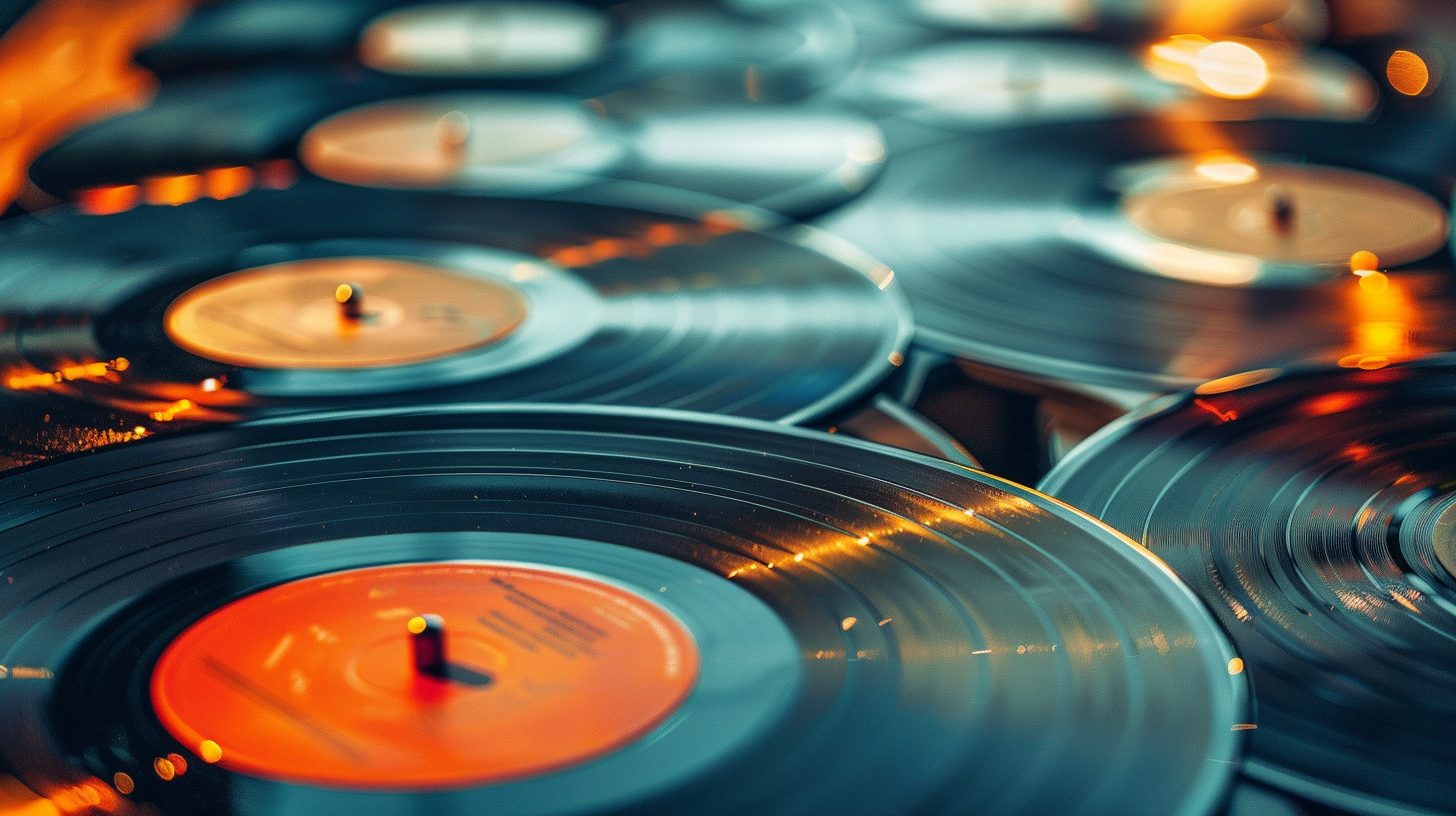Table of Contents Show
As they say, the only constant in life is change, and nowhere is this more evident than in the way we’ve experienced music over the decades. We’ve journeyed from the tangible warmth of vinyl records to the ephemeral nature of streaming, reshaping not just how we listen to music but how it influences our culture and connects us. Each era brought its innovations, from the portability of the Walkman to the ubiquity of smartphones, fundamentally altering our musical landscape. As we stand on the cusp of yet another shift, it’s worth exploring how these changes have not just reflected our technological advances, but also shaped our social interactions. What lies ahead could redefine our relationship with music once more.
Key Takeaways
- Music consumption evolved from physical formats like vinyl to digital streaming platforms.
- Portable devices, from Walkmans to smartphones, transformed where and how we listen to music.
- Digitalization liberated music from physical constraints, enabling access to vast libraries instantly.
- Advances in AI and VR are shaping more immersive and personalized music experiences.
The Vinyl Era Begins
In the late 1940s, we saw the introduction of vinyl records, revolutionizing how people experienced music. This wasn’t just a new format; it was a gateway to freedom, allowing us to immerse ourselves in a piece of our favorite artists in our hands and control what we listened to, when, and how. We weren’t just passive listeners anymore; we became curators of our own musical journeys.
Before vinyl, we were at the mercy of radio broadcasts or live performances. But with vinyl, we finally had the power to choose. We could engross ourselves in an album from start to finish, flipping sides with a sense of anticipation for what was to come next. It wasn’t just about listening; it was an experience. We’d pore over album covers, decipher lyrics, and get lost in the artwork, all while the record spun its magic.
This era also sparked the beginning of music collection. We’d save up, rush to the record store, and flick through the racks for our next musical obsession. It wasn’t just about owning a record; it was about claiming a piece of history, a snapshot of culture that we could revisit any time we dropped the needle.
Vinyl brought us together, too. We’d gather around turntables, share our latest finds, and debate the merits of different genres and artists. It was a social experience, a communal appreciation of artistry that transcended the music itself.
As we moved through the decades, music consumption continued to evolve, but the vinyl era remains a proof of our desire for choice, control, and connection in how we experience music.
Rise of the 8-Track
As we delved further into the music revolution, the 8-track tape emerged, offering a new level of convenience and portability. This invention wasn’t just another way to listen to music; it represented a leap towards freedom and flexibility in how we consumed our favorite tunes. Suddenly, we weren’t tied down to the living room record player anymore. Let’s explore the reasons why the 8-track tape caught our fancy:
- Portability: For the first time, we could take our music with us in our cars, making every drive an opportunity to soundtrack our journey with the latest hits or our personal favorites.
- Durability: Unlike vinyl records, which could scratch and warp, 8-tracks were more resilient. We didn’t have to treat them like delicate treasures, which suited our increasingly mobile lifestyles perfectly.
- Longer Playtime: 8-tracks allowed for uninterrupted listening experiences with a continuous loop feature. We could enjoy albums without the need to flip sides or change records.
- Simplicity: With push-button operation, the 8-track tapes offered us a hassle-free way to play music. There was no need to carefully place a needle or worry about tracking force.
The rise of the 8-track tape was about more than just technology; it was about redefining the boundaries of where and how we could enjoy music. It gave us a taste of freedom, setting the stage for future innovations that would continue to liberate our musical experiences.
Cassette Tapes Take Over
Following the era of 8-track tapes, we now turn our attention to the takeover by cassette tapes. These compact devices revolutionized music listening with their portability, allowing us to enjoy tunes anywhere. Moreover, the emergence of mixtape culture enabled us to curate and share personalized playlists, fostering a new way of connecting through music.
Portability Revolutionizes Listening
With the advent of cassette tapes, we witnessed a monumental shift in how music was consumed, making it more portable and accessible than ever before. This change wasn’t just about technology; it was about freedom. Suddenly, we could take our favorite tunes everywhere, breaking free from the confines of static listening spaces. Here’s how:
- Walkmans: These portable cassette players revolutionized when and where we listened to music.
- Car Stereos: Music on the go became the norm, transforming road trips and commutes.
- Durability: Unlike vinyl, tapes were less prone to damage, making them ideal for on-the-move listening.
- Affordability: Cassette tapes were cheaper, allowing us to explore a wider range of music without breaking the bank.
This era set the stage for the boundless musical exploration we enjoy today.
Mixtape Culture Emerges
The emergence of mixtape culture, fueled by the widespread adoption of cassette tapes, fundamentally transformed the way we shared and discovered new music. It was our rebellion against the mainstream, a passport to musical freedom. We’d curate playlists, recording tracks off the radio or from vinyl, crafting personal soundtracks of our lives.
| Era | Medium | Impact |
|---|---|---|
| 1970s-80s | Cassette Tapes | Birth of Mixtape Culture |
| Personal | Handcrafted | Emotional Connection |
| Sharing | Community | Boundless Exploration |
This wasn’t just about music; it was a form of expression, an art. Each mixtape was a story, a gift, a message. We weren’t just listeners; we were creators, connectors, revolutionaries. In those moments, music wasn’t just heard; it was felt, shared, lived.
The Compact Disc Revolution
In the early 1980s, the music industry witnessed a seismic shift as compact discs, commonly known as CDs, began to dominate the market. We watched as these shiny, futuristic discs promised not just better sound quality but a new era of convenience and durability that vinyl records or cassette tapes couldn’t match. CDs became the symbol of modern music consumption, blending technology with the art of music in ways we’d never imagined.
Here’s why we embraced CDs with open arms:
- Superior Sound Quality: CDs offered crystal-clear sound without the pops and crackles of vinyl, revolutionizing how we experienced music. It was like hearing our favorite songs for the first time again.
- Durability: We no longer fretted over scratches ruining our music. CDs were resilient, promising a longer life for our beloved albums.
- Portability: Carrying our favorite albums became effortless. A stack of CDs in a carry case meant we could bring our music everywhere, sharing it freely with friends.
- Extra Features: Many CDs came packed with bonus content like exclusive tracks and artist interviews, giving us more bang for our buck.
This shift wasn’t just about adopting a new format; it was about claiming our freedom to enjoy music on our terms. We reveled in the sheer abundance of choice and control over our listening experience. CDs allowed us to curate our collections meticulously, ensuring every disc reflected a piece of our identity. As we moved forward, this desire for freedom and quality in music consumption continued to shape the industry, guiding us towards new horizons.
The Portable Walkman Phenomenon
Before CDs revolutionized our music collections, we often turned to the portable Walkman to satisfy our on-the-go listening desires. This small, battery-operated device gave us the freedom to take our favorite tunes wherever we roamed, liberating music from the confines of our living rooms. The Walkman wasn’t just a gadget; it was a statement of personal freedom, a declaration that we could enjoy our music without boundaries or limitations.
We quickly embraced the Walkman, marveling at how it transformed our music experience. For the first time, we could curate our own soundtracks for the day, escape into our own worlds on crowded commutes, or find solace in our favorite songs during a stroll in the park. This level of personalization and freedom was unprecedented.
| Feature | Impact on Music Consumption |
|---|---|
| Portability | Allowed music to be enjoyed anywhere, anytime. |
| Personalization | Enabled listeners to create custom playlists on the go. |
| Privacy | Offered a personal listening experience without disturbing others. |
The Walkman phenomenon underscored our desire for a more intimate connection with our music. It paved the way for future innovations in music consumption, each seeking to offer more freedom and flexibility. As we moved away from bulky vinyl and embraced the compact cassette, we celebrated not just the evolution of technology, but the liberation of our musical experiences. The Walkman was more than a device; it was a revolution, one that we fondly remember as a stepping stone towards our current landscape of streaming and digital downloads.
Boomboxes and Public Listening
While the Walkman personalized our music experiences, boomboxes brought our tunes into the public sphere, sharing beats and rhythms openly. They weren’t just devices; they were statements of identity and freedom. As we carried them over our shoulders, we declared our musical tastes to the world without saying a word. They made music communal again, breaking down the invisible barriers that personal devices had erected.
Boomboxes symbolized more than just a way to listen to music; they represented a movement towards shared experiences and cultural expression. Here’s how they reshaped our world:
-
Public Spaces Became Stages: Parks, streets, and beaches transformed into impromptu concert venues where anyone could be the DJ. This democratization of music presentation allowed for a diverse set of sounds to permeate every corner of our communities.
-
Breakdancing and Hip-Hop Culture Flourished: The portability of boomboxes played a pivotal role in the rise of breakdancing and hip-hop. Sidewalks turned into dance floors where battles were fought with moves, not words.
-
Music Sharing Became Tangible: We didn’t just listen; we exchanged cassette tapes, discovering new music and artists through friends. This physical sharing of music fostered a sense of belonging and community.
-
A Symbol of Rebellion: Carrying a boombox was an act of defiance. It challenged norms, pushing back against the notion that music was a private affair. We weren’t just listeners; we were bold participants in the musical landscape.
Boomboxes allowed us to claim our spaces and celebrate our freedom through the universal language of music.
The Advent of Digital Audio
As we move forward in our journey, we’re now reaching a pivotal shift with the advent of digital audio. This era brought us the MP3 revolution, fundamentally changing how we access and consume music. It led to the rise of music platforms and had a significant impact on the sales of physical media.
MP3 Revolution Begins
The MP3 revolution kicked off in the late 1990s, transforming the way we access and enjoy music. Suddenly, we weren’t tethered to physical formats like CDs or tapes. This shift offered us unprecedented freedom, letting us curate personal playlists and share tracks with a click. Here’s how it changed our world:
- Portability: We could carry thousands of songs in our pockets, making music an ever-present companion.
- Access: Discovering new genres and artists became effortless, broadening our musical horizons.
- Sharing: Swapping songs with friends or online communities fostered a new culture of music distribution.
- Space: We said goodbye to bulky CD collections, freeing up physical space for other passions.
This era didn’t just change how we consumed music; it revolutionized our relationship with it.
Rise of Music Platforms
Building on the MP3 revolution, the early 2000s witnessed the emergence of digital music platforms, reshaping our access to tunes even further. Suddenly, we weren’t just downloading songs; we were streaming them, discovering new genres, and connecting with artists from around the globe at the click of a button. It was freedom in a form we’d never experienced. The convenience was unparalleled. Gone were the days of bulky CDs and limited storage. We now had vast libraries at our fingertips, ready to soundtrack our lives at a moment’s notice. It wasn’t just about listening anymore; it was about exploring, sharing, and experiencing music in a way that bonded us all. This era marked a pivotal shift, cementing the idea that music should be accessible anywhere, anytime, to anyone craving its magic.
Impact on Physical Sales
How did the advent of digital audio shake the foundations of physical music sales? We’ve witnessed a seismic shift, where freedom to access music anytime, anywhere became a reality. Here’s how it unfolded:
- Decline in CD Sales: We saw CDs collect dust as digital downloads soared.
- Closure of Record Stores: Our beloved haunts for discovering music couldn’t compete with the click-to-play convenience.
- Rise of Digital Marketplaces: Platforms like iTunes offered us liberation from physical constraints.
- Music on the Go: Our playlists now travel with us, unchained from bulky players or stacks of discs.
Digital audio didn’t just change how we buy music; it revolutionized our very relationship with it, granting us unprecedented freedom and choice.
MP3s and Music Piracy
With the dawn of MP3s, we witnessed a seismic shift in music consumption, marked by the rise of music piracy. As we embraced this new digital format, we found ourselves caught in the crosshairs of an ethical dilemma. The convenience of downloading music from the internet, often without cost, beckoned us with a siren’s call. We reveled in the newfound freedom to access vast libraries of music that were previously beyond our reach or budget.
The allure of MP3s wasn’t just in their portability or the ease with which we could share them; it was in the empowerment they offered. For the first time, we weren’t tethered to the whims of record labels or limited by the physical constraints of CDs and vinyl. We could curate our music collections with unprecedented autonomy, discovering obscure bands and genres that would have remained hidden in the pre-digital era.
However, our celebration of this freedom came with its consequences. The music industry reeled as traditional sales plummeted, grappling with how to adapt to a world where music was increasingly seen as a free commodity. Artists and record labels voiced concerns over lost revenues, while we, the consumers, championed the democratization of music access.
As we navigated this new landscape, the debate around music piracy intensified. We found ourselves at a crossroads, defending our right to access and share music freely while confronting the ethical implications of our choices. The conversation around music consumption had irrevocably changed, setting the stage for the next evolution in how we interact with the art we love.
The Ipod and Personal Playlists
Amid the debates over music piracy, the introduction of the iPod substantially altered our approach to curating personal music collections. Suddenly, we found ourselves in a new era where our favorite tunes could travel with us, unbound by the physical constraints of CDs or vinyl records. This shift wasn’t just about convenience; it was a revolution that played into our deepest desires for freedom and personal expression.
Here’s how the iPod and personal playlists gave us a newfound sense of liberty:
-
Unprecedented Portability: We were no longer tethered to our home stereo systems. The iPod allowed us to carry thousands of songs in our pockets, making our music accessible anytime, anywhere.
-
Personalized Soundtracks: With the ability to create playlists, we could curate soundtracks for every aspect of our lives. Whether for a workout, a road trip, or a quiet evening at home, our music could reflect our mood and enhance every moment.
-
Discovery on Our Terms: Browsing through our vast collections, we’d often stumble upon forgotten gems or tracks that hadn’t yet caught our attention. This personal journey of discovery was ours alone, free from the influence of radio DJs or the limitations of mixtapes.
-
Sharing Our World: The playlists we crafted became a way to share a piece of ourselves with others. Each playlist was a reflection of our personality, tastes, and experiences, offering a unique way to connect.
The iPod era was more than just a technological advancement; it was about reclaiming our autonomy over how we experienced music. In this sense, the device wasn’t just playing songs; it was playing the soundtrack of our lives, on our terms.
Online Music Stores Emerge
As the digital revolution gained momentum, online music stores quickly became the new frontier for accessing and purchasing music. We were suddenly granted the freedom to explore vast libraries of songs from the comfort of our homes. This shift wasn’t just about convenience; it was a liberation of sorts—breaking away from the physical limitations of CDs and vinyl records.
We embraced these platforms because they offered us the power to tailor our music collections without the need to purchase entire albums. Singles became our playground, allowing us to curate personalized playlists that resonated with our individual tastes. It was a transformative experience, shaping not just how we consumed music but how we connected to it on a personal level.
The emergence of these online music stores also democratized music distribution. Independent artists found a voice, a place where they could share their work without the gatekeeping hurdles of traditional record labels. We reveled in the discovery of new, obscure tracks that we likely wouldn’t have encountered in a physical record store.
But it wasn’t just about the music. These platforms introduced us to a new form of interaction with music, through reviews, ratings, and recommendations. We weren’t just buyers; we became part of a community, engaging in dialogues about our musical preferences and discoveries.
In essence, online music stores reshaped our relationship with music. We weren’t just passive listeners anymore; we became active participants in a broader musical ecosystem, empowered by the freedom to explore, discover, and define our musical identities.
The Shift to Music Streaming
The evolution from online music stores to streaming services fundamentally changed how we access and enjoy our favorite tunes. Suddenly, we’re not just buying songs; we’re subscribing to all of them. This shift has given us an unprecedented level of freedom and convenience, liberating us from the confines of physical media and even the need to own digital files.
Music streaming platforms have become our go-to for discovering new artists, genres, and playlists. Here’s why we’ve embraced streaming with open arms:
- Unlimited Access: We’ve gained the ability to listen to millions of songs on-demand, without the need to purchase each track or album individually. It’s like having the world’s largest record collection at our fingertips, available anytime, anywhere.
- Personalized Experiences: Streaming services learn from our listening habits, introducing us to music we’re likely to enjoy but might never have discovered on our own. This personal touch keeps our playlists fresh and exciting.
- Social Sharing Features: We can easily share our favorite music with friends or see what others are listening to, making music discovery a shared experience. It’s a way to connect through tunes we love, despite any distance.
- Cost-Effective: For the price of a couple of album downloads a month, we get access to an entire universe of music. It’s an unbeatable deal for anyone who loves to explore and enjoy a wide variety of music without breaking the bank.
Streaming isn’t just a method; it’s a movement towards a more liberated and inclusive way to experience music.
Impact of Smartphones and Apps
Smartphones and apps have further propelled our music streaming experience into a realm of unparalleled convenience and personalization. We’ve witnessed a transformation that’s not just about accessing music but about integrating it seamlessly into our daily lives. With a tap on our screens, we’re now able to immerse ourselves in oceans of melodies, curate playlists that resonate with our moods, and discover tunes that were once beyond our reach.
This revolution has empowered us with the freedom to choose not only what we listen to but also how we engage with music. Whether we’re on a crowded train or in the solitude of our rooms, our favorite tracks are always within reach. This accessibility has blurred the lines between the public and private listening experiences, allowing us to enjoy music in ways we’ve never imagined.
In addition, the advent of smartphones has sparked a surge in app development, each aiming to enhance our musical journey. From apps that help us identify songs with just a snippet of melody to those offering immersive audio experiences, the possibilities are endless. We’re no longer passive listeners but active participants in the music ecosystem, tailoring our listening habits to fit our individual lifestyles.
It’s clear that smartphones and apps have not just changed how we access music; they’ve redefined our relationship with it. As we move forward, we’re excited to see how this blend of technology and creativity continues to evolve, offering us even more freedom to explore, discover, and connect with music in new and exciting ways.
Music Streaming Services Dominate
In recent years, music streaming services have become the primary way we consume music, revolutionizing the industry and our listening habits. Gone are the days of physical collections; we’ve embraced the endless domains of digital tunes. This shift isn’t just about convenience—it’s about freedom. The freedom to explore any artist, any album, anytime, without the confines of what’s in our physical possession.
Here’s why we’ve all gravitated towards streaming:
- Unlimited Access: We’ve got the world of music at our fingertips. Whether it’s discovering a new artist or replaying our childhood anthems, streaming services provide an infinite library.
- Personalization: Algorithms learn what we love, recommending tracks that often hit the mark. It’s like having a personal DJ who knows our tastes better than we do ourselves.
- Portability: We can take our music anywhere. Whether we’re working out, commuting, or just chilling at home, our playlists are always with us, seamlessly integrated across our devices.
- Affordability: For the price of a single album per month, we gain access to virtually all music ever recorded. This has democratized music consumption, making it accessible to anyone with an internet connection.
We’ve become the curators of our own musical experience, liberated from the limitations of past formats. Streaming services haven’t just changed the way we listen to music; they’ve transformed our relationship with music, making it a more integral part of our lives than ever before.
Future Trends in Music Consumption
Having explored how streaming services have reshaped our music consumption habits, let’s now consider what the future holds for how we’ll experience music. As we look ahead, it’s clear that the drive towards more personalized, immersive experiences will continue to shape our musical journey. We’re diving into an era where artificial intelligence (AI) and virtual reality (VR) aren’t just buzzwords but pivotal elements in music consumption.
Imagine a world where music isn’t just heard but felt and seen, thanks to VR concerts that bring us face-to-face with our favorite artists, no matter where we are. We’re talking about immersive experiences that go beyond the confines of our headphones, offering us the freedom to interact with music in a way that’s tailor-made for our tastes and moods. AI-driven algorithms will play a critical role here, not just in recommending songs but in creating personalized soundscapes that adapt to our emotions in real-time.
We’ll also see a surge in high-quality, lossless audio streaming, as demand for audiophile-grade experiences grows. This shift will democratize music production and distribution, enabling independent artists to share their work in the highest fidelity without the need for major label backing.
But perhaps the most liberating trend will be the rise of decentralized platforms, giving power back to the creators and fans. These platforms will foster a direct artist-listener relationship, cutting out the middlemen and reshaping music’s economic landscape.
The future of music consumption is not just about listening; it’s about experiencing music in a way that’s more engaging, personal, and empowering.
Conclusion
So, we’ve danced from the bulky charm of vinyl to the sleek, soulless swipe on our screens. We’ve tossed aside the tactile joy of flipping records for the convenience of endless scrolling. Our music, once a collection to display with pride, now lives in the cloud, as ephemeral as our attention spans. As we stream into the future, let’s remember, it’s not just the tunes that have changed, but how we’ve chosen to lose ourselves in them. Here’s to progress, I guess.








